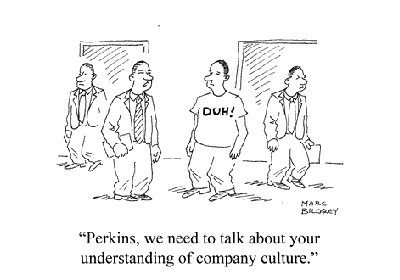You have probably never focused as tightly on driving revenue and reducing costs as you do today. People in business are working under great pressure; job security is a thing of the past; and the only thing that really seems to matter is ‘making the numbers’.
As a result, any work around employee attitudes, company values or corporate culture often gets squeezed out. But by ignoring these issues, you are missing a key leverage point for improving your company’s performance.
There’s plenty of evidence to demonstrate the link between high performance and a positive working environment:
A major study published in 2001 proved not only that is there a link between employee attitudes and profitability; improvements in employee satisfaction ‘cause a demonstrable, measurable improvement in financial performance’.
The Sunday Times has reported that companies that ‘have put the welfare of their staff to the fore…even in depressed conditions… are outperforming the rest of the market’.
Here are four tips for establishing a corporate culture that adds value to your bottom line:
Be clear what you want
Start by setting objectives and deciding how the change will be measured. How will things be different? By when will that have been achieved? How will you know if you have been successful?
Use three or four key values to define the new culture. Increasing the number dilutes the impact.
Be specific about the behaviours and attitudes you’d like to see. Choosing ‘Trust’ as a company value is meaningless, because nobody knows what is expected of them. Defining trust as “Believing in the honesty, goodwill and commitment of others, and acting consistent with that belief” makes it very clear what is expected, and sets a standard against which everyone’s behaviour can be judged.
Manage the new culture
Changing attitudes and behaviours across a business isn’t easy. The change process has to be managed as rigorously as any other aspect of company performance.
The surest way to kill off a change programme is to position it as an HR issue. Every manager in the company will breathe a sigh of relief, because “if its HR’s job, it obviously isn’t mine”. It sends a very different signal when the CEO takes personal accountability, and makes it clear that every functional Director or Divisional Head will report personally on progress in their area.
Review everything you do against the values
Review, and redesign where necessary, every process and policy to reflect the new culture. For example, in staff appraisals, performance should be evaluated against each of the company values, as well as conventional targets and objectives. Reward systems may need to be changed. Don’t expect real Teamwork if bonuses are linked to individual performance.
People often fail to realise that in committing to a strong, distinctive culture, they are by definition excluding other ways of doing things. If you are out to create a company focused on Customer Service, anyone who is regularly the subject of customer complaints has to change or leave.
Walk the talk
As soon as people hear about new company values they will want to know whether or not to take them seriously. If you and your Senior Management Team aren’t seen to live and breathe the values, nobody else will. Change your behaviours where they don’t reflect the company values. If your habit of yelling at people and throwing furniture is inconsistent with your new commitment to Show Respect for People, stop shouting and throwing furniture! And when you get it wrong – and you will! – apologise.
[callout title=”What are your company values?” button=”We can help” link=”/services/organisation-development/” buttoncolor=”white, yellow, orange, red, blue, green, gray, black, alternative-1, alternative-2, alternative-3″ target=”_blank or _self”]Develop a culture where you all stand for the same values[/callout]
